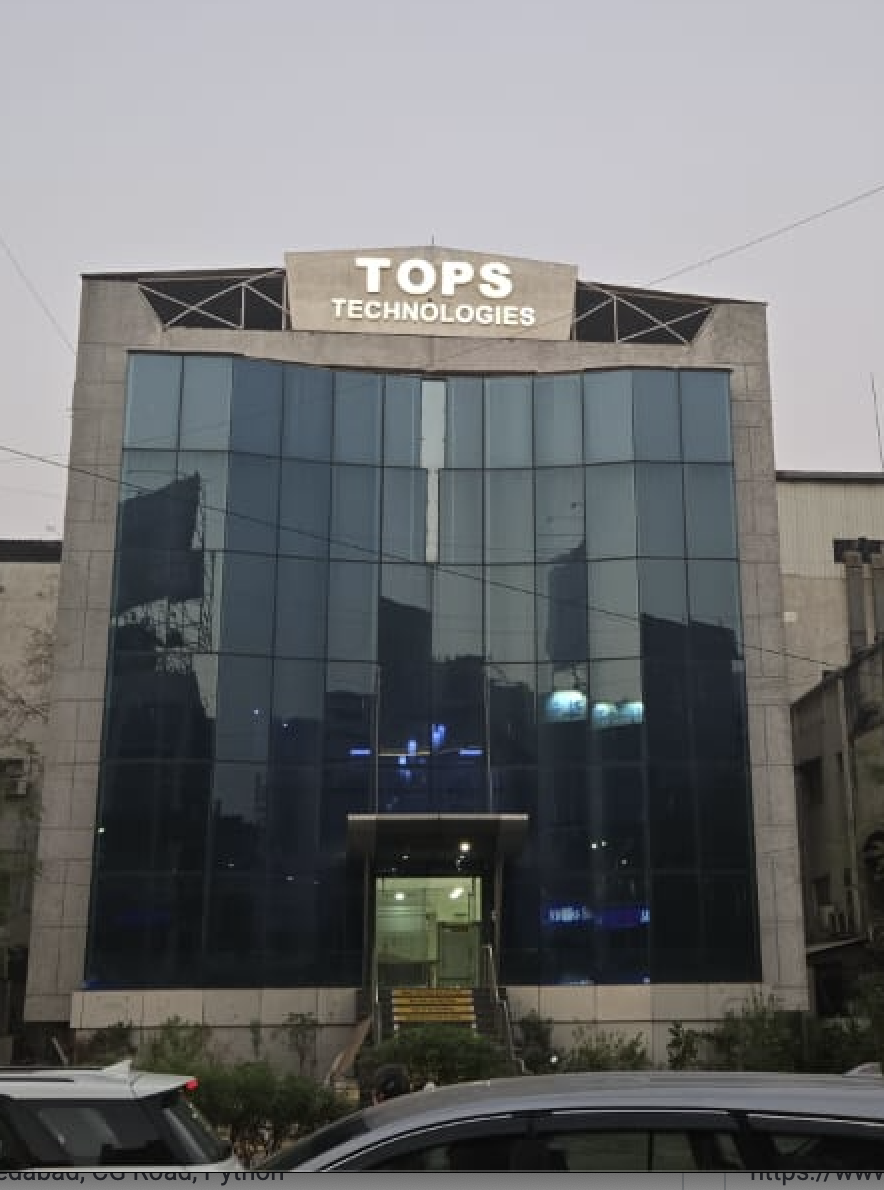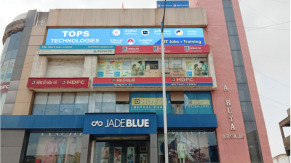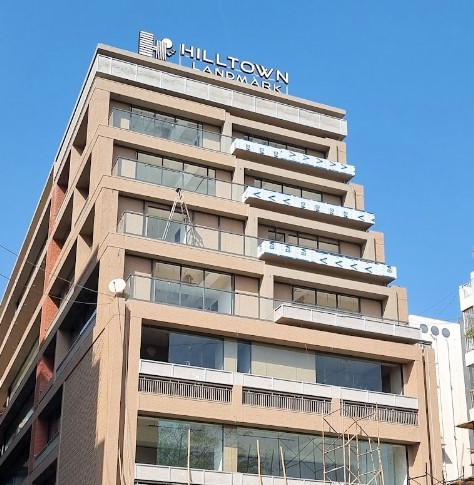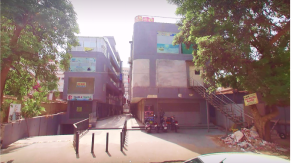Our Facts and Figures
1 Lac+
Student Placed
3000+
Companies TieUp
19+
Offices in India
50+
Industry Courses
Get 100% Job Assistance by enrolling in Certified Full Stack Training Course
Key Highlights
Limited Students Batch
Personalised Attention
Highly Qualified Teachers
Flexible Batch Timings
Interactive Learning
Live Projects
Career Support
Job Oriented Training
Full Stack Development Course Highlights
Full Stack Developer Course in Ahmedabad — Learn Web Development with 100% Placement
TOPS Technologies offers the most trusted Full Stack Developer Course in Ahmedabad, combining web, database, and blockchain training with real-world projects and guaranteed placement assistance. With 4 major training centers across the city — CG Road, Maninagar, SG Road, and Nikol — we make learning accessible for students and professionals seeking the best full stack developer course with placement.
Our Full Stack Development Course in Ahmedabad helps learners become job-ready with live projects, mentorship, and hands-on coding experience — ideal for anyone searching for full stack training in Ahmedabad or full stack developer classes near me.
- Live Full Stack & Blockchain Projects
- Expert Faculty with 10+ Years of IT Experience
- Industry-Recognized Certification
- Flexible Batch Timings & Weekend Options
- Dedicated Placement Assistance & Career Support
Why Learn Full Stack Development in Ahmedabad?
Ahmedabad is rapidly becoming a hub for software and startup innovation. Skilled developers are in high demand for companies adopting web and blockchain technology stacks. Our full stack development course in Ahmedabad prepares you for front-end, back-end, and database roles with job-oriented, project-based learning.
TOPS Technologies is among the best full stack developer institutes offering ai-integrated modules, placement support, and a complete full stack course in Ahmedabad that blends technology and career readiness.
Who Can Enroll in Our Full Stack Developer Course in Ahmedabad?
Our Full Stack Developer Courses in Ahmedabad are open to learners of all levels — from freshers to professionals. Anyone passionate about web, backend, and blockchain development can join our Full Stack Training in Ahmedabad.
- Computer Science Graduates
- Freshers starting their IT careers
- Professionals switching to software development
- Students seeking a Full Stack Developer Course with Certification
- Aspirants aiming to master both frontend and backend web development
Our curriculum is frequently updated with the latest technologies. Learn software design, development, and deployment to start building your own applications right after completion.
What to Expect from the Best Full Stack Developer Course in Ahmedabad?
- Industry-Approved Certification
- Expert Mentorship from Real-World Developers
- Comprehensive Curriculum (Beginner to Advanced)
- Hands-On Training with Live Client Projects
- Soft Skills and Career Counseling
- 100% Placement Assistance via JobFest & Campus Drives
Curriculum Overview
- Frontend: HTML5, CSS3, JavaScript, ReactJS
- Backend: Node.js, Express.js, REST APIs
- Database: MongoDB, MySQL
- Version Control: Git & GitHub
- DevOps & Deployment: AWS, Docker
- Blockchain: Solidity, Smart Contracts, Web3.js
- Capstone Project: Full Stack Blockchain Web App
Placement & Career Support
TOPS Technologies offers full placement assistance through exclusive JobFest, Campus Drives, and Placement Partnerships. Students receive dedicated interview preparation, mock sessions, and career guidance — ensuring they secure roles as Full Stack or Blockchain Developers in top companies.
Ahmedabad Centers
TOPS Technologies CG Rd
Address: TOPS House, 2 Shanti Sadan Society, CG Road, Ahmedabad, Gujarat, IN
About CG Road (Wikipedia)Phone: +91 09974 755006
Areas served: CG Road, Navrangpura, Naranpura, Paldi, Satellite, Vastrapur, Ellis Bridge, Ambawadi, Thaltej, Bodakdev, Law Garden, Mithakhali
TOPS Technologies SG Road
Address: 102, Baleshwar Square, SG Highway, Ahmedabad, Gujarat, IN
About SG Highway (Wikipedia)Phone: +91 09904 422211
Areas served: Prahladnagar, Sarkhej, Bopal, Shela, Thaltej, Gota
TOPS Technologies Maninagar
Address: 401, Amruta Arcade, Lala Lajpat Rai Marg, Maninagar, Ahmedabad, Gujarat, IN
About Maninagar (Wikipedia)Phone: +91 09974 863333
Areas served: Maninagar, Behrampura, Kankaria, Isanpur, Danilimda
TOPS Technologies Nikol
Address: 401 HillTown Landmark Nikol - Naroda Rd, Opp. Das Khaman, Nikol, Ahmedabad, Gujarat, IN 382350
About Nikol (Wikipedia)Phone: +91 07624 007666
Areas served: Nikol, Naroda, Bapunagar, Rakhial, Vastral, Odhav
Launch your career as a Full Stack Developer! Enroll today in the best Full Stack Development Course in Ahmedabad at TOPS Technologies — and gain real-world experience, placement support, and certification that employers trust.
40%
Average Salary Hike
4.5 Lacs
Highest Salary
3000+
Hiring Partners
Join Our Free Upcoming Webinar
Learn Python in 60 Minutes
18 Dec 2025, 04:00 PM
Trainer
Sanket Chauhan
(Sr. Technical Trainer)
Want to protect yourself against Malware
19 Dec 2025, 04:00 PM
Trainer
Faruk Pathan
(Sr. Technical Trainer)
Fastest Way to Learn Data Science and Actually Get a JOB
21 Dec 2025, 11:00 AM
Trainer
Dhrumil Joshi
(Sr. Technical Trainer)
Python Full Stack Development
21 Dec 2025, 12:30 PM
Trainer
Anjali Patel
(Sr. Technical Trainer)
Motion Graphics and Animation in Design
21 Dec 2025, 02:00 PM
Trainer
Saurabh Verma
(Sr. Technical Trainer)
Learn the Website Hacks and Provide Better Security
21 Dec 2025, 04:00 PM
Trainer
Faruk Pathan
(Sr. Technical Trainer)
Full-Stack Web Development with PHP and Laravel
20 Dec 2025, 11:00 AM
Trainer
Rajesh Nagar Mngr
(Sr. Technical Trainer)
Android UI Design with Kotlin
20 Dec 2025, 12:30 PM
Trainer
Prakruti Vyas
(Sr. Technical Trainer)
Digital Marketing with AI
20 Dec 2025, 02:00 PM
Trainer
Sanket Chauhan
(Sr. Technical Trainer)
Automated vs. Manual Testing: Choosing the Right Approach
20 Dec 2025, 04:00 PM
Trainer
Rahul Sanghavi CG
(Sr. Technical Trainer)
Full Stack Development Course Curriculum
Download Curriculum- C Language – Control statements (if, . else statements , nested if statement , switch statement) ,looping statements (for, while ,do .. while)
- C++ : Oops concepts (class, objects, inheritance , polymorphism , data abstraction, encapsulation)
- Html 5, Tags, Input Forms
- Css3
- Sql
- CRUD operations queries
- Select statements
- Where clauses
- oin queries
- HTML-(1 session)Basic HTML like What is Tags attribute property Form Tag HTML-HTML5 tags
- CSS (1) Selectors • Margin-Padding-display property • Create login-registration page
- Bootstrap (2) Grid Rows-Cols • Forms-Cards
- SQL-(MySQLi)(4)
- SQL Queries
- Normalization
- Joins
- Indexer
- Practical Examples 1) MySQL data types 2)Create Multiple Tables and perform the queries using Select, Update, Delete, Insert Where, Like, Group By, Having, Limit, Offset, Sub Query and Or, Not, In 3) Function and procedure 4) Trigger 5) Views 6) Primary a
- PHP array
- PHP expression
- PHP function
- PHP operations
- String Function
- PHP String
- Practical Example: 1)Display the value of the array 2) To Find the number of odd and even element in array. 3) Create associative array for user detail and display the user detail. 4)shifted all the zero in bottom up of the array
- HTTP Protocol
- PHP syntax
- PHP variable
- Super Global Variables
- Practical Example: 1) Create Multiple Tables and perform the queries using Select,Update,Delete,Insert Where,Like,Group By,Having,Limit,Offset,Sub QueryAnd ,Or,Not,In
- Conditions Events and flows
- If condition
- If else if
- Practical Example : 1)Make Simple Calculator 2) Find the current day and if it is Sunday than print happy Sunday
- Practical Example: 1) Restaurant food Category Program using Switch case Display Which Category and dish user 2) Using Ternary display age if it is greater than 18 3)Display Name Of the color which user selected
- Do While Loop
- For each Loop
- For loop
- Practical Example : 1) Create a script that displays 1-2-3-4-5-6-7-8-9-10 on one 2) Create a script using a for loop to add all the integers between 0 and 30 and display the total. 3)Write a PHP script using nested for loop that creates a chess board 4)Al
- Array Function
- Date-time function
- Header function
- Include require
- Practical Example: 1) Perform all the 2)In user define function: 3)Create calculator 4)Find factorial using recursion 5)Reverse string without function 6) Download file on button click
- SDLC OOPS :Object Oriented Programing Class – object Inheritance Polymorphism Encapsulation Abstraction Aggregation
- SQL : Importance of Database CRUD JOIN QUERIES
- Front-End Fundamental : HTML , CSS , JavaScript , Jquery
- ViewBag,ViewData,TempData 2 MVC Life Cycle 3 Razor Controls
- State Management 5 JavaScript,Jquery,Ajax 6 Web Api
- EDM & LINQ & Net Differences practical
- OOPs Concepts
- Class
- Object
- Extends
- Overloading
- Abstraction interface
- Constructor
- Destructor
- Magic Methods
- Scope Resolution
- Traits
- Visibility
- Type hinting
- Final keyword
- Email security function
- File handling
- Handling emails
- MVC Architecture
- Practical Example: Implementation of all the Oops Concept
- Connection with MySQL database
- SQL injection
- Practical : 1) Take Project Definition 2) Exception handling with try catch for database connection and all 3) Server- side Validation while Registration using Regular expressions. 4) Send mail while registration
- Session and cookies
- File upload
- PHP with MVC Architecture
- Insert, Update, Delete MVC
- Practical Example: 1) Apply session cookies concepts 2) File uploading and downloading 3) Bootstrap data-table Pagination
- Java script
- JQuery
- JQuery Events
- JQuery Validation
- Practical Example: 1)Alert, Prompt, Confirm 2)Create calculator 3)Create slideshow 4)Validation using JavaScript 5)Hide show using jQuery
- PHP and Ajax
- AJAX (crud)
- Regular Expression
- Practical Example :1) Event Examples (Onblur,onkeypres) 2)Regular expression 3) Create dependent drop down Pagination using ajax jQuery in MVC Project Insert Files using Ajax
- Payment Gateway Integration
- -> Create API With Header -> API with Image Uploading
- Practical Example: Payment Gateway Implement on MVC Project
- -> SOAP and REST AP, Create API for insert, update and delete
- Product Catalog
- Shopping Cart
- Web Services
- Practical Example: Create Web Services for MVC Project Integration of API in Project
- Installing Laravel
- Artisan CLI ( command-line interface )
- Laravel Directory Structure
- Configuring a new Laravel project
- Artisan command to generate boilerplate code for a controller
- Basics of laravel—— > Routing
- Controller
- Middleware
- Request
- Response
- HTML Template to Laravel Blade Template
- HTML Template to Laravel Blade Template———- > Template inheritance
- Master layout
- Extending the master layout
- Displaying variables
- Blade conditional statements
- Blade Loops
- Executing PHP functions in blade
- Displaying Your Views
- Creating and using a basic views
- Loading a view into another view/nested views
- Adding assets Integrating with Bootstrap
- Introduction
- Requirements for running migrations
- Artisan migration command
- Migration structure
- How to create a table using a migration
- Laravel migration rollback
- Database Seeding
- Migrations for our project database Pagination
- Creating contact us form
- Validating user input
- Sending email
- Creating a file uploader
- Validating a file uploader
- Creating a custom error message
- Laravel Collective—— > Installation
- Opening A Form
- Form Model Binding
- Form controls
- Custom macros
- Introduction
- Creating a basic controller
- Creating a route using a closure
- Making the controller RESTful
- Using route groups
- Building a RESTful API with routes
- Rest API with Passport Authentication
- Event
- Queue
- Task Scheduling
- Eloquent ORM and Models—— > Naming conventions
- Table name and primary keys
- Timestamps
- Eloquent ORM INSERT, READ, UPDATE, DELETE
- Relationship
- Using models in controllers
- Displaying data from models in views
- Creating and Using Composer Packages———- > Downloading and installing packages
- Using a basic Shopping Cart package in our project
- socialite
- Using Ajax and jQuery—– > Getting data from another page
- Setting up a controller to return JSON data
- Creating a Jquery, AJAX comment system
- Security & Session—— > Using Security Sessions Effective
Our TOPS Training Centers in India
Course Key Features
Skills Covered
Job Roles
Get Training Certificate by Government
Recognized NSDC/Skill India

- National Skill Development Corporation
- Supported by the vision of PM Shri Narendra Modi
- Certification by NSDC SkillIndia
- Valid for all Jobs and College Training
- International Recognition

Student Reviews
Rishi Kumar
Full Stack DeveloperThe Full Stack Developer course at TOPS Technologies Ahmedabad gave me a complete understanding of both front...
Read MoreMaitri Shuthar
Full Stack DeveloperThe placement assistance at TOPS Ahmedabad was very effective. After completing the Full Stack course, I recei...
Read MoreNeha Dave
Full Stack DeveloperMy experience with the full stack training was excellent. The combination of front end, back end, and deployme...
Read MoreKrisha Patel
Full Stack DeveloperI highly recommend the Full Stack Developer course at TOPS Technologies. The curriculum is modern and updated,...
Read MoreKrish Patel
Full Stack DeveloperTOPS Technologies Ahmedabad ka Full Stack course genuinely value for money hai. Daily tasks aur assignments ne...
Read MoreDevyang Patel
Full Stack DeveloperThe full stack course at TOPS Ahmedabad prepared me well for the industry. The real projects improved my probl...
Read MoreMahek Soni
Full Stack DeveloperTOPS Technologies offers one of the most complete full stack programs in Ahmedabad. The trainer explained each...
Read MoreKinjal Dave
Full Stack DeveloperI really enjoyed the full stack training at TOPS Ahmedabad. The course covered everything from UI design to AP...
Read MoreMehali Modi
Full Stack DeveloperThe Full Stack Developer course at TOPS Technologies Ahmedabad gave me hands on experience with both front end...
Read MorePiyush Balwani
Full stack DeveloperI'm studying in TOPS Technologies (CG road) from last 7 months and currently in Full-Stack development course....
Read MoreFAQ
The cost of a Full Stack Developer Course in Ahmedabad may vary depending on the program's length and the particular college offering it. Depending on the institution, the costs might range from a few thousand to a few lakhs.
Yes, in Ahmedabad, we provide Full Stack live project training. We give our students the best instruction and preparation in this area.
Please get in touch with us right away if you have any questions regarding our Full Stack live project training in Ahmedabad or our Full Stack Developer Course in Ahmedabad. We would be delighted to talk with you about your options and address any queries you may have.
After mastering Full Stack Web Development, you might want to think about looking in Ahmedabad for a career. There are numerous chances for exceptional Full Stack Developers in this city, which is home to some of the best and most well-known agencies in India.
Your next step is to send your CV and portfolio to agencies and companies in Ahmedabad if you are confident in the abilities and credentials you acquired at Full Stack Institute in Ahmedabad. Additionally, you could wish to show up to job interviews on behalf of other applicants. Last but not least, if you don't hear back right away, keep up the excellent job and maintain your positive attitude; eventually, someone will give you an opportunity.
The top Full Stack Institute in Ahmedabad that offers a Full Stack Developer Course with Placement is TOPS Technologies. For those looking to enter the software development industry, this course is ideal. The Full Stack training tutorial offers a thorough comprehension of the concepts and methods used in Full Stack Web Development. The course also provides placement services to aid students in locating Full Stack Web Development employment.
A Full Stack Developer in Ahmedabad may earn up to Rs.15 lakhs a year on average, based on data from recent studies and polls. Nevertheless, based on each applicant's level of expertise and the Full Stack Institute in Ahmedabad from where they graduated, the pay scale may vary.
If you want to effectively get ready for your forthcoming Full Stack Developer interview, consulting TOPS Technologies is something you should think about doing. With years of industry expertise, we are convinced that our team of specialists can help you reach the results you seek.
In addition to offering preliminary Full Stack training lessons, we also give you access to our most recent tools and resources so you can sharpen your abilities immediately. Additionally, our team is always on hand to offer assistance and respond to any queries you might have.
Get in touch with us right away to find out more about our Ahmedabad Full Stack Developer interview preparation services!
Absolutely. As digital transformation accelerates, companies seek versatile professionals who can manage end-to-end web solutions. Full stack developers are in high demand across industries like fintech, healthcare, e-commerce, and startups.
Full stack developers rely on a suite of tools, including:
- Code Editors: VS Code, Sublime Text
- Version Control: Git, GitHub
- Testing & API Tools: Postman, Swagger
- Development Tools: Node Package Manager (npm), Webpack, Docker
- UI Debugging Tools: Chrome DevTools, React Developer Tools
To become a proficient full stack developer, you should learn:
- Frontend: HTML, CSS, JavaScript
- Backend: Node.js, Python, PHP, Java, or Ruby
- Databases: SQL for structured data and NoSQL like MongoDB for unstructured data
- Learning JavaScript is especially valuable, as it can be used in both frontend (React.js) and backend (Node.js).
It typically takes 6–9 months of focused and consistent learning to become proficient. This timeline includes understanding key technologies, completing projects, and practicing coding regularly. However, the pace may vary based on individual dedication and prior experience.
Interview Questions
Authentication and authorisation are two fundamental concepts in computer security often used to control access to resources.
Authentication refers to verifying a user's or system's identity, typically through usernames and passwords or other authentication mechanisms such as biometric authentication. The purpose of authentication is to ensure that only authorised individuals or systems are allowed access to a resource.
Authorisation, conversely, refers to determining whether an authenticated user or system has the necessary permissions to access a particular resource or perform a particular action. Authorisation typically involves using access control lists (ACLs) or role-based access control (RBAC) to specify who can access resources and under what circumstances.
Authentication is verifying a user's identity, while authorisation is granting or denying access based on that user's identity and permissions. Both authentication and authorisation are essential components of a comprehensive security strategy and are used in virtually every aspect of modern computing, from accessing online banking to securing corporate networks.
Full-stack development requires session and cookie management to guarantee that online applications work effectively and securely. When a user signs into an application, sessions are generated, and cookies are little files saved on their device to remember their preferences and behaviours.
Full-stack development session and cookie management considerations are as follows:
Sessions: A session is a unique identifier generated whenever a user connects to an application. This identifier retains the user's status during their interaction with the program. Sessions are often used to store user information such as their name, email address, and preferences on the server.
Cookies: Cookies are little files kept on a user's device to remember their activities and preferences. Cookies may record information such as a user's login credentials, language preferences, and shopping cart contents. Cookies may be either temporary or permanent, and the user's web browser manages them.
Session and Cookie Management: Appropriate session and cookie management are essential to ensure the security and operation of online applications. Session management, for instance, helps prevent cross-site scripting (XSS) threats, while cookie management can prevent session hijacking.
Best Practices: Some best practices for the session and cookie management include encrypting sensitive data, establishing proper cookie expiry dates, and employing HTTP-only secure cookies.
Client-side rendering (CSR) and server-side rendering (SSR) are two rendering approaches for web applications. The primary distinction between them is where the rendering takes place.
These are a few important distinctions between server-side rendering and client-side rendering:
Server-Side Rendering (SSR) is a technique for displaying web applications in which the server creates HTML for the browser to display. The server transmits a whole HTML page to the browser, which renders the content. This method is often used for static material and may enhance website performance, particularly for search engine optimisation (SEO).
Client-Side Rendering (CSR) is a technique for rendering web applications in which the rendering happens on the client's computer. The server transmits a simple HTML page to the browser, which then loads JavaScript files to construct the user interface. This method is used for dynamic information and may result in a more engaged user experience.
SSR may enhance website performance and SEO, but initial page load times might be slower. CSR may give a more involved user experience, but it might hinder website performance and cause SEO problems.
Front-end and back-end development are the two major areas of web development, each focusing on a distinct part of creating a website or online application. Front-end developers are responsible for a website's layout, navigation, and interaction, ensuring that it is aesthetically attractive and user-friendly.
Front-end development, commonly called client-side development, is concerned with a website's user interface and user experience. It entails creating and constructing the visual components of a website utilising technologies like HTML, CSS, and JavaScript.
Back-end development, often known as server-side development, is concerned with the functionality of a website or online application that operates behind the scenes. It entails planning and constructing the server-side architecture that drives a website or online application.
This may involve creating and managing databases, server-side programming languages, and application programming interfaces (APIs). Back-end developers are responsible for maintaining the proper operation of a website or web application by handling data processing, user authentication, and server resource management.
Agile methodology is an iterative software development process that stresses cooperation, adaptability, and continual improvement. It entails dividing a project into tiny, manageable chunks and completing them in two- to four-week sprints.
The objective of the agile approach is to provide a high-quality product that satisfies the client's demands quickly and effectively.
Following are some essential aspects of the agile approach and its applicability to full-stack development:
The agile technique is focused on four fundamental values: humans and interactions, functioning software, customer participation, and adaptability. These principles stress cooperation, flexibility, and client satisfaction.
Many behaviours define agile methodology, including daily stand-up meetings, sprint planning, and retrospective meetings. These techniques contribute to the team's efficiency and effectiveness.
The agile technique is advantageous for full-stack development because it helps teams swiftly adjust to changing needs and produce high-quality solutions on time. Also, it fosters cooperation, communication, and collaboration, all of which contribute to improving the project's quality.
One of the problems of the agile approach is that it needs a high degree of cooperation and communication among team members. In addition, the agile approach may be challenging to apply to big, complicated projects.
Node.js is a JavaScript runtime environment built on Chrome's V8 engine. It allows developers to run JavaScript on the server side. Its non-blocking, event-driven architecture makes it lightweight and efficient, suitable for real-time applications like chats, APIs, and streaming services. Being able to use one language (JavaScript) across the stack makes Node.js very popular in full stack development.
Express.js is a minimalist web framework for Node.js that simplifies backend development. It provides a robust set of features like routing, middleware, request handling, and template engines. Express is widely used for building RESTful APIs and full-stack web applications due to its speed and flexibility.
To enhance frontend performance, developers can:
- Minify CSS, JavaScript, and HTML files.
- Use lazy loading for images and resources.
- Enable browser caching for faster repeat visits.
- Optimize image sizes and formats.
- Reduce HTTP requests by combining files.
- Use CDNs (Content Delivery Networks) to serve static files quickly.
Responsive web design ensures that websites look and function well on all screen sizes and devices. It uses flexible grids, layouts, images, and CSS media queries to automatically adjust the UI. This provides an optimal user experience whether the website is accessed from a desktop, tablet, or smartphone.
The DOM (Document Object Model) is a programming interface that represents a web page as a tree structure where each node is an object. JavaScript uses the DOM to manipulate HTML and CSS—adding elements, changing content, or responding to events—enabling dynamic and interactive websites.
In CSS, classes and IDs are selectors used to target HTML elements, but they differ in usage and specificity:
- ID (#): Uniquely identifies one element on a page. It has the highest specificity and should not be reused for multiple elements
- Class (.): Can be applied to multiple elements, making it more flexible and reusable across the document.
In practice, classes are preferred for general styling, while IDs are used for unique components like navigation bars or specific containers.
A responsive website adapts to different screen sizes and devices, ensuring a seamless user experience. This is achieved by:
- Using media queries to apply different styles based on screen width.
- Creating flexible layouts using percentages instead of fixed units like pixels.
- Employing fluid grids and responsive images that scale based on screen size.
- Leveraging frameworks like Bootstrap or Tailwind CSS, which offer pre-designed components and grid systems that simplify responsive design.
Flexbox (Flexible Box Layout) is a CSS layout module designed for distributing space and aligning items efficiently within a container. It allows you to control the direction, alignment, and spacing of elements, even when the size of the items or the container is dynamic or unknown. Flexbox is especially useful for building responsive layouts without having to rely on floats or positioning. Common properties include justify-content, align-items, and flex-wrap.
- Relative positioning moves the element from its original place based on offset values (top, bottom, left, right) without removing it from the normal document flow.
- Absolute positioning places the element in relation to its nearest positioned (non-static) ancestor. It is removed from the normal flow and positioned exactly where specified.
- Fixed positioning anchors the element relative to the browser window. It stays in the same position even when the page is scrolled, making it useful for sticky headers or navigation bars.
The CSS box model describes how every HTML element is rendered as a rectangular box. It consists of four layers:
- Content: The actual text or image inside the element.
- Padding: Space between the content and the border.
- Border: A visible line surrounding the padding (optional).
- Margin: Space outside the border that separates the element from others.
Understanding the box model is essential for controlling layout, spacing, and element sizing effectively on web pages.
JavaScript is a high-level, dynamic scripting language primarily used to make web pages interactive. Unlike HTML and CSS, which handle structure and styling, JavaScript adds behavior to websites. It enables features like animations, interactive forms, dynamic content updates, real-time validations, and user-driven events without reloading the page. It runs in the browser, making it essential for modern, user-friendly web applications.
- Variables in JavaScript are containers for storing data values. They are declared using var, let, or const.
- var is function-scoped and was used traditionally.
- let and const are block-scoped and are preferred in modern JavaScript due to their cleaner behavior and better predictability.
- let is used when a value can change, while const is used for constants whose value should not be reassigned.
Functions are reusable blocks of code that perform a specific task. They allow you to write logic once and use it multiple times, making code organized, modular, and maintainable. JavaScript supports named functions, anonymous functions, and arrow functions. Functions can also be passed as arguments, enabling functional programming and event handling.
The == operator checks for value equality with type coercion, meaning it converts the operands to the same type before comparison.
- Example: 5 == '5' is true.
- The === operator checks for strict equality, meaning both value and data type must match.
- Example: 5 === '5' is false.
- Using === is considered a best practice for predictable and accurate comparisons.
Arrays are ordered collections of data stored under a single variable. They can hold numbers, strings, objects, or even other arrays (nested arrays).
Example: let fruits = ['apple', 'banana', 'cherry'];
They allow data to be accessed using indices starting from 0. JavaScript provides many built-in methods like push(), pop(), map(), filter(), and reduce() to manipulate arrays efficiently.
Latest Blogs
Graduate Success Stories from the TOPS Full Stack...
Discover inspiring success stories from TOPS Full Stack course graduates and learn how live-project...
View full BlogTransitioning into Full Stack Development: A Caree...
Embarking on a career in full-stack development offers a rewarding pathway in the tech world. Whethe...
View full BlogHow can I switch from front-end to full stack deve...
On the other hand, Full Stack Development is a broader domain that covers both the front-end and bac...
View full BlogFull Stack Developer Interview Questions
By investing your time in these Full Stack Interview Questions and Answers, you're not just preparin...
View full Blog








